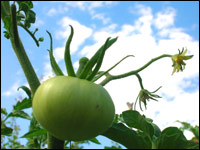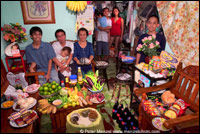In the valuable new book Fields of Plenty: A Farmer’s Journey in Search of Real Food and the People Who Grow It, author Michael Ableman rambles across the country in a VW van, visiting small-scale farmers to talk with them at the table and in the field.
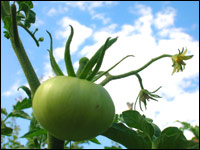
Vine and dandy.
Photo: Chrissi Nerantzi.
Not surprisingly, he encounters an array of colorful characters, including Bob Cannard, a celebrated Northern California micro-scale organic farmer. Whereas most farmers — even organic ones — work mightily to beat back weeds, Cannard exults in his. In fact, he’s trying to obliterate the distinction between weed and crop. “I hope I survive long enough to see my soil so rich that I won’t have to plant anymore,” he tells Ableman. “Wild potatoes and Swiss chards and kales and lettuces already grow here like weeds. If I am lucky and get to be an old fart, I’m just going to go out and pick what I need.”
As a vision of paradise, Cannard’s dream harks back to Eden, that land of orchards where dinner could literally be plucked off a tree. Adam and Eve offended God and found themselves in trouble: “Cursed is the ground for thy sake; in sorrow shalt thou eat of it all the days of thy life,” thunders the Lord at his fallen charges. The curse, it turns out, was agriculture.
The ancient Hebrews were onto something: Food is a vexation. Growing it from the soil is backbreaking work, requires vast amounts of energy, and doesn’t always succeed. Then, of course, there’s the drudgery of cooking. In the U.S., we’ve tried hard to put the food problem behind us, mechanizing the process and leaning heavily on foreign-born workers, both on farms and in restaurant kitchens. It is an odd irony that these people are often labeled “aliens” and hounded as criminals. Who else would feed us?
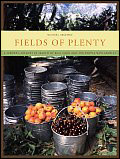
Fields of Plenty, by Michael Ableman, Chronicle Books, 255 pgs, 2005.
Today, 2 percent of the population grows food for the other 98 percent. Despite our liberation from land and kitchen, food remains a vexation. Our post-agricultural lifestyles and processed foods have made us overweight and unhealthy; the environmental costs of industrial agriculture are piling up and becoming difficult to ignore; and many people are beginning to see that, compared to countries with vibrant food cultures — say, Mexico, Italy, Thailand — our food tastes horrible.
Fields of Plenty weaves a well-told narrative around a lovely set of photos, also by Ableman, documenting a determined and growing movement designed to reframe the food problem in the U.S. Ableman, a working farmer himself, focuses his pen and camera on small-scale organic growers who hail from a variety of ethnic and economic backgrounds. All seem intent on reclaiming the (sorry, God) sensual pleasure of cultivating, cooking, and eating. For them, food is still a vexation — but not just a vexation.
Ableman’s subjects are generally a cranky and utopian lot, whose customers — presumably mostly Epicureans, status-conscious yuppies, and environmentalist types who want to avoid pesticides and chemical fertilizers — are a relatively tiny portion of our population. But what about the rest of the world? What goes into their food decisions — what pressures do they face, what cultural and economic constraints do they operate under, why do they eat what they eat? How, in short, do they deal with the vexation of food? Those questions are grappled with, on a global scale, by the photographer/writer team Peter Menzel and Faith D’Aluisio in their wonderful new coffee-table book Hungry Planet: What the World Eats. Like Fields of Plenty, it’s well-written and lavishly illustrated. Together, the books present a fascinating snapshot of contemporary global food culture, where it is and where it may be heading.
Feed the World
The conceit of Hungry Planet is simple and irresistible: Menzel and D’Aluisio visit 30 families across the world, spending a week with each to talk food and eat. At the end of the week, the family poses in its dining room with the following week’s victuals (paid for by the authors). Menzel’s camera catches folks in everyday acts of shopping, cooking, and eating; D’Aluisio pens a brief but detailed account of their attitudes toward food and how it fits into their lives. Each profile is accompanied by a family recipe.
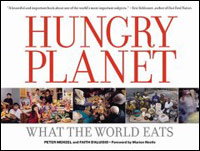
Reverse the Curse
Hungry Planet, by Faith D’Aluisio and Peter Menzel, Ten Speed Press, 287 pgs, 2005.
The exercise is journalistic, not academic. “We found our subjects … through colleagues, translators, fixers, friends, and taxi drivers,” Menzel (who writes intermittently, and well, throughout) informs us in an afterword. “We were looking for representative people, but not necessarily statistically average people.”
The result is an unlikely page-turner, powered by the sheer variety of human existence. While subjects range from a family of Sudanese refugees scratching out a living in a temporary camp in Chad to a prosperous North Carolina family struggling with weight issues, the authors deftly avoid bathos and facile critique. What we get is documentation, and sympathetic but rigorous storytelling.
Among my favorite highlights is the profile of the Cabaña family of Manila, in the Philippines. The authors capture the chaos, grandeur, and despair of the global South’s mega-cities, whose populations have swelled for half a century as neoliberal economic policies have forced subsistence farmers off the land. Angelita, matriarch of the eight-member extended Cabaña family, emerges as one of the book’s most compelling figures. To her grandchildren, she is “chef de cuisine of the noodles and eggs, the keeper of the Cheez Whiz.” She’s also master of the art of suki, an intricate relationship between buyers and sellers in Manila’s bustling food markets. “Over time,” writes D’Aluisio, “the relationship — like a non-corporate loyalty card — can garner deep discounts for the buyer and ensures the seller a steady customer. To Lita, the discount might mean the difference between buying a snack-size or a meal-size portion of some item.”
It is on these sorts of calculations that a city like Manila — nearly 15 million strong, with its share of poverty — functions. And while the Philippines has operated as a de facto U.S. colony for about 100 years, and assimilated much of our processed-food fetish into its Polynesian culinary heritage, poverty and sheer will have kept fresh, locally grown food at the center of the table. An array of fresh fruit, vegetables, and fish dominates Menzel’s portrait of the Cabañas; industrial food, often in knockoff form (“Pop”-brand cola), lies at the margin.
“Every now and then we have extra money and I get to buy roast chicken from a restaurant,” Angelita tells D’Aluisio. “We get by, and though our food may not be as expensive as what the rich people eat, it is just as delicious.”
Hungry Planet explores the contradictions that characterize humanity’s efforts to feed itself in our time. In the industrialized north, food tends to be cheap, plentiful, and convenient, but maladies associated with overeating abound. In the Southern Hemisphere, the authors document subsistence farmers either more or less thriving (in the fertile soil of Ecuador and Bhutan) or struggling (in the near-desert conditions of Chad); or urban dwellers such as the Cabañas, managing to preserve some semblance of old foodways under severe time and economic pressure. In these places, hunger lies only a failed harvest or a missed paycheck away.
Clearly, we have yet to sort out the vexations of eating.
In Fields of Plenty, Ableman points to a way forward. His motley array of growers approach agriculture from a variety of angles; all, though, dedicate themselves to feeding the people immediately around them. “I know firsthand that a small piece of land can feed a large number of people,” Ableman writes. “So why shouldn’t all housing developments include small farms? Why shouldn’t they be at least as important as the community pool? Shouldn’t developers consider food as part of a broad range of basic needs … no less important than water, electricity, and sewers?”
Ableman wants to retrieve food from the margin of human life, where it makes plenty of trouble, and plunk it right down at the center. But he doesn’t paint a sentimental picture of what such a world would be like. Like the subsistence farmers in Hungry Planet, some of his subjects struggle to coax food out of the soil.
The Old Testament God, surely one of literature’s grouchiest characters, was right: Our need to feed ourselves is a curse, and a daily one. Thus, these two books suggest, we might as well do it with as much style, grace, and pleasure as possible.
